
August 26, 2024
Tackling challenges with gusto, these winning scholars examine each research problem and develop novel approaches to personalize patient treatment, reduce side-effects for current treatment protocols and expand life sciences research.
Razan El Khaled El Faraj, a doctoral candidate from the Karlsruhe Institute of Technology (KIT; Karlsruhe, Germany), is overcoming the technical challenges associated with miniaturizing protocols for gene expression analysis in nanoliter droplets. Ohad Meir, Ph.D., a postdoctoral fellow from the Blavatnik Center for Drug Discovery (BCDD) at Tel Aviv University (Tel Aviv, Israel), is identifying candidate compounds capable of inhibiting protein-protein interactions that play a central role in activation of the immune response.
These separate research journeys intersected in the SLAS Europe 2024 Student Poster Competition as each researcher participated and then took home a €500 award. The two winners also received an invitation to submit their work for fast-track publication consideration in one of SLAS’s two scientific journals, SLAS Discovery (Advancing Life Sciences R&D) and SLAS Technology (Translating Life Sciences Innovation). The duo also earned SLAS Travel Awards, presented to students, graduate students, post-doctoral associates, junior faculty (less than four years in first academic appointment), or emerging scientists (less than four years into their career), to cover their conference registration, airfare and hotel accommodations to present their work. Learn more about the research behind these emerging scientists as they share their stories and discoveries.
Personal Experience Drives Research Goals

El Khaled El Faraj is committed to studying various cancer types and developing personalized treatment methods because of her personal experiences with losing loved ones to the disease. “The potential impact on patient care is what motivates and drives me most about my work,” says El Khaled El Faraj, who also appreciates the collaborative nature of the research. “The opportunity to work with experts from various fields, including bioinformatics and clinical medicine, often leads to unexpected insights and breakthroughs.”
Her winning poster, “Miniaturizing Drug-Induced Differential Gene Expression Analysis for Precision Oncology on Droplet Microarray,” involves a collaboration with Heidelberg University Hospital to miniaturize protocols for gene expression analysis in nanoliter droplets. This work includes developing and optimizing protocols to analyze gene expression in patient-derived chronic lymphocytic leukemia (CLL) cells, aiming to identify the most suitable drug treatment for individual patients.
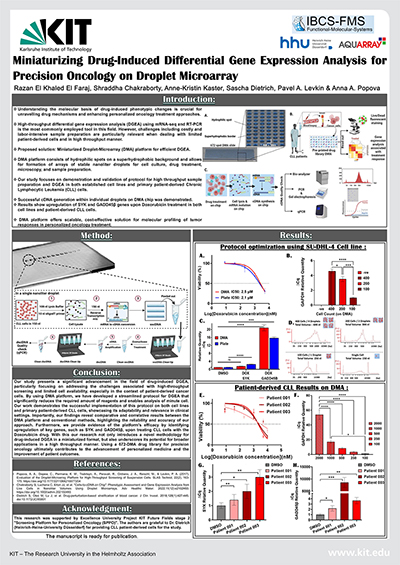
“Receiving positive feedback from peers and working alongside leading researchers in the field is incredibly exciting, as it validates the importance of my work and motivates me to continue pushing boundaries,” El Khaled El Faraj continues. “This collaborative effort brings us closer to achieving personalized oncology treatments that can be used in clinics and hospitals, ultimately improving patient outcomes.”
Her academic journey reflects her dedication to this field. El Khaled El Faraj first pursued two master's degrees with a focus on cancer treatment methods. At Cyprus International University, (Nicosia, Cyprus), she investigated the cytotoxic effects of endemic plants, Ferula communis and Juniperus sabina, on breast cancer cells. At the University of Saint-Étienne (Saint-Étienne, France), her research focused on using an ovo-model for glioma treatment. “Presently, as a Ph.D. candidate at KIT, I am using the droplet microarray (DMA) platform to develop methods for personalized oncology treatment,” she says.
The biggest challenge in her research at KIT, El Khaled El Faraj reports, is the technical complexity of miniaturizing gene expression analysis protocols using the DMA platform. “Despite thorough planning, the process required more iterations and troubleshooting than I expected,” she comments. “Ensuring accuracy and reproducibility in such small volumes required extensive optimization and troubleshooting.”
In addition, her move to Germany brought its own challenges. Adjusting to a new country and learning a new language while pursuing a Ph.D. was demanding. “Balancing these personal and professional challenges required effective time management and strong perseverance.
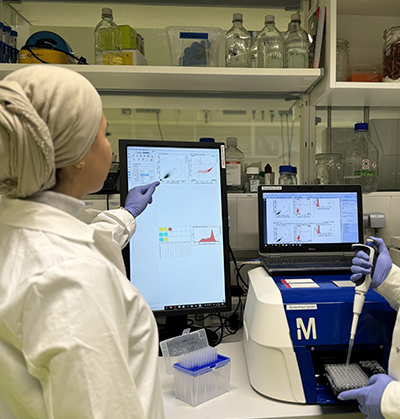
"These experiences have been incredibly rewarding and have contributed significantly to my growth as a researcher,” says El Khaled El Faraj, who copes with day-to-day stress and supports a healthy lifestyle by going to the gym. She also enjoys traveling, discovering new cultures and meeting new people, “which gives me fresh perspectives and mental energy.”
Next up for El Khaled El Faraj? “I’m interested in exploring how combining traditional treatments with novel agents to improve gene expression analysis can further enhance personalized treatment strategies,” she says, adding that she wants to help improve the accuracy and efficiency of identifying the most effective treatments for individual patients by using these technologies.
“I want to contribute to the development of groundbreaking research that advances our understanding and treatment of different types of cancer,” El Khaled El Faraj continues. “Whether in academia or industry, I want to be at the forefront of developing innovative therapies that bring hope and improve outcomes to cancer patients worldwide.”
Reducing Side Effects Inside and Outside the Lab
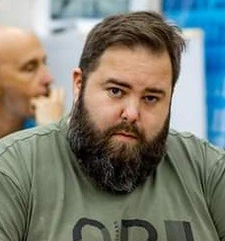
Meir’s poster from SLAS Europe 2024, “High-Throughput Screening for Inhibitors of Calcineurin and NFAT Protein-Protein Interaction,” outlines a high-throughput screen (HTS) campaign that aims to identify candidate compounds capable of inhibiting the protein-protein interaction between calcineurin and NFAT that have a central role in activating the immune response.
“While this interaction is properly regulated in health, there are several instances in which its curbing is desired – such as with chronic inflammations and autoimmune diseases, or following organ transplantations,” Meir explains, adding that few drugs today perform effectively as inhibitors. “However, they lack specificity, and thus their administration involves side-effects. At the BCDD at Tel Aviv University, our team and collaborators identified an opportunity to tackle this challenge in an alternative method to the current clinically used drugs.”
While current drugs target calcineurin’s catalytic center, thereby preventing its activity on a variety of substrates (including NFAT), “we targeted an allosteric site known to be involved in the interaction with NFAT, without obscuring the catalytic center,” Meir says.
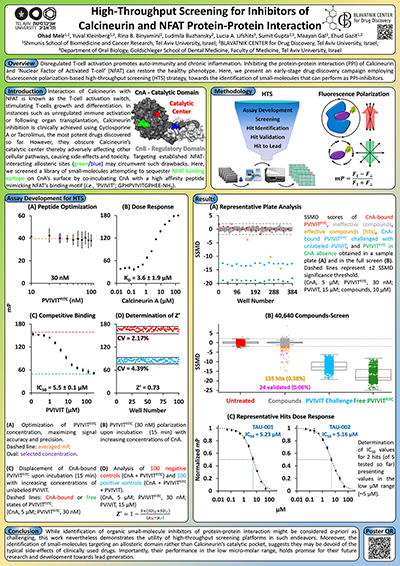
“Identification of compounds capable of achieving such an outcome presents an attractive goal that we considered worth pursuing,” he continues. “If successful, such a drug would benefit patients by reducing side effects as compared with current treatment protocols and could be utilized for a wide array of medical indications.”
Meir’s team established a fluorescence polarization based HTS platform, where they co-incubated calcineurin A (which contains the NFAT binding domain) with a fluorescently labeled peptide mimicking NFAT’s binding epitope. Initial stages consisted of calibration assays of both the technical instrumentation parameters and assay conditions such as concentrations, duration, temperature and more.
“Next, we characterized the binding kinetics and coefficients, followed by relevant HTS parameters. Once these were in place, we performed a screen of approximately 40,000 compounds, out of which less than 20 compounds were identified as hits, after validation,” Meir reports. “We knew of a couple similar previous attempts that were unsuccessful, so we were very encouraged by our results.”
Collaboration is key at BCDD, Meir observes. “We collaborate with various researchers from academia, hospitals, in Israel and abroad – and thus we have opportunities to interact, collaborate and become exposed to different fields of study, techniques and strategies. In my opinion, the multifaceted nature of our work is unique even in academic settings where scientists push the boundaries of knowledge on a daily basis.”
Meir notes that as in any research campaign, the critical evaluation of the results, whether good or bad, is crucial for the project’s success. “This is especially important when working in a group setting, in which different strategic views may be present,” he continues, adding that researchers can overcome most challenges by breaking down objectives to small manageable tasks. “This approach increases your personal satisfaction and sense of accomplishment, thus improving motivation for the next task.”
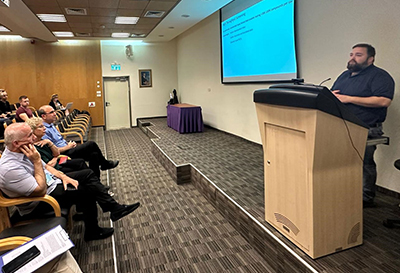
He also underscores the importance of time off for recuperating and charging one’s personal battery. “You enable greater output in the long run,” he says, mentioning that he achieves this by occupying his brain with chess, puzzles, cooking and the occasional TV show.
As for his next steps in this research, Meir comments that the team will continue to explore the identified hits and improve their properties through medicinal chemistry. “Additionally, I am involved in various drug discovery campaigns pertaining to various diseases, including types of cancer, metabolic disorders, as well as neurological and ophthalmological diseases,” he says. In addition, Meir is currently exploring opportunities for post-doctoral positions abroad, especially in the fields of synthetic biology, toxicology and antimicrobials development.
“In a few years’ time, I hope to join the academic arena and establish a research lab of my own,” he concludes.
Sidelines
Apply for an SLAS Travel Award to SLAS2025! Submissions Due Monday, September 9
Gain Exposure for Your Research! Poster Abstracts for SLAS2025 Due Monday, September 16
